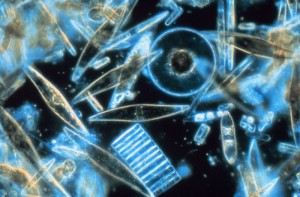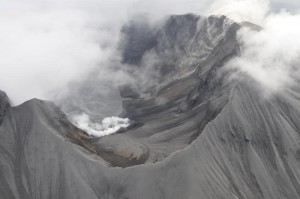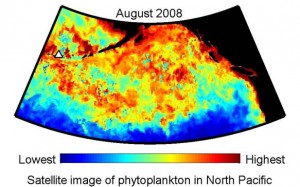 Nature certainly works in dark, mysterious ways. A few weeks ago, we marveled here at the seemingly miraculous return of 35 million sockeye salmon to Canada’s Fraser River, after many people feared that the run was nearing extinction.
Nature certainly works in dark, mysterious ways. A few weeks ago, we marveled here at the seemingly miraculous return of 35 million sockeye salmon to Canada’s Fraser River, after many people feared that the run was nearing extinction.
As Canadians were rejoicing, however, fisheries scientists were frantically working their chalkboards, trying to figure out what on earth was going on. Now someone has come up with a theory. The greatest Fraser River run in nearly a century may have been due to two events: the eruption of Kasatochi volcano in the Aleutian Islands in August 2008, and the winds of a perfect storm.
 Fishery scientist Timothy Parsons at University of British Columbia, came up with this idea after examining two lines of evidence. The first, published this month, comes from oceanographer Roberta Hamme and her colleagues who tracked Kasatochi’s ash cloud. While local winds normally blow ash in just one narrow direction, something different happened in the summer of 2008. A nascent storm cell picked up Kasatochi’s ash and swirled it across a huge area. And this sparked a vast marine feeding frenzy, because the ash that came raining down—sometimes in pebble-sized pieces—contained iron, a nutrient normally in short supply in the northeast Pacific.
Fishery scientist Timothy Parsons at University of British Columbia, came up with this idea after examining two lines of evidence. The first, published this month, comes from oceanographer Roberta Hamme and her colleagues who tracked Kasatochi’s ash cloud. While local winds normally blow ash in just one narrow direction, something different happened in the summer of 2008. A nascent storm cell picked up Kasatochi’s ash and swirled it across a huge area. And this sparked a vast marine feeding frenzy, because the ash that came raining down—sometimes in pebble-sized pieces—contained iron, a nutrient normally in short supply in the northeast Pacific.
Bathed in iron-rich water, phytoplankton in the region did what well-fed phytoplankton the world over do: they bloomed. And they bloomed so profusely that satellites circling the earth recorded vast patches of their chlorophyll concentrations. These images, along with data gathered by an oceanographic ship that just happened to be in the area in 2008, convinced Hamme, an oceanographer at the University of Victoria, and her colleagues that something rare and remarkable had taken place. Kasatochi turned the northeast Pacific bright green.
 But how did all those furiously multiplying phytoplankton give rise to a record salmon run hundreds of miles to the south in the Fraser River? Parsons has spent decades studying the oceanic behavior of the Fraser River sockeye: His work reveals that the class of 2010 would have been feeding in the Gulf of Alaska just as the phytoplankton bloomed. If he is right, these fish would have profited handsomely from the windfall, hunting all the creatures that fed on that forest of phytoplankton.
But how did all those furiously multiplying phytoplankton give rise to a record salmon run hundreds of miles to the south in the Fraser River? Parsons has spent decades studying the oceanic behavior of the Fraser River sockeye: His work reveals that the class of 2010 would have been feeding in the Gulf of Alaska just as the phytoplankton bloomed. If he is right, these fish would have profited handsomely from the windfall, hunting all the creatures that fed on that forest of phytoplankton.
It’s a wonderful idea, and yet it fills me with sadness. What are the chances that Kasatochi will erupt at just the right time again and that a perfect storm will spread its ash far and wide around the Pacific? A million to one? A billion to one?
I fear all those children growing up along the Fraser will never again experience the beauty of a river red with fish.
The Adams River is a tributary of the Fraser.
Upper photo: Phytoplankton. Courtesy of Gordon T. Taylor, Stony Brook University.
Middle photo: Crater and rim of Kasatochi volcano, August 22, 2008. Photo by Ray Buchheit. Courtesy of Alaska Volcano Observatory.
Lower satellite image: Courtesy of Roberta Hamme, University of Victoria.
–Heather Pringle